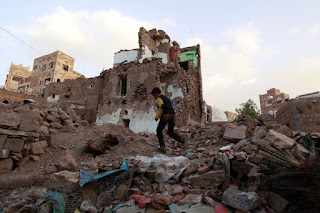fter a year of civil war, there is a glimmer of hope for long-suffering Yemen. The main combatants, Iranian-backed Houthi rebels and Saudi-backed government forces, have agreed to a cease-fire starting April 10, and the United Nations plans to revive peace talks a week later.
Saudi Arabia is said to be looking for a way out of the war, but whether Saudi leaders and the Houthis can agree on a political solution remains a big question. In a show of good faith, the two sides did complete a prisoner exchange involving nine Saudis and 109 Yemenis.
The conflict has been a disaster — for Yemen but also for the region, Saudi Arabia and the United States, which supported the Saudi military intervention that human rights groups and the United Nations say resulted in war crimes. It needs to end now.
A Saudi-led coalition of mostly Sunni Arab nations began the air war a year ago with the aim of defeating the Houthis, an indigenous Shiite group, and reinstalling President Abdu Rabbu Mansour Hadi, whom the rebels had ousted from power. Although initially reluctant, President Obama agreed to support the effort with intelligence sharing, weapons and in-flight refueling of aircraft.
The Saudis, under a new king and an inexperienced defense minister, decided to take direct action against the forces of Shiite Iran because they feared Tehran was gaining influence in the region. Although the Saudis overstated Iran’s role, Mr. Obama apparently felt it was necessary to support them, perhaps in part to appease Saudi outrage over the Iran nuclear agreement.
The cost of this proxy war is staggering. More than 6,200 people have been killed, almost half of them civilians, and more than 30,000 have been wounded, the World Health Organization said this week. On Tuesday, Unicef said at least 934 children have been killed and 1,356 wounded. More than 80 percent of Yemen’s 24 million people need humanitarian aid.
There have been reports of abuses by the Houthis, but the top United Nations human rights official, Human Rights Watch and others say the majority of civilian deaths have been from indiscriminate airstrikes by the Saudi coalition. Schools, hospitals and electricity and water supplies have been destroyed. Last month, 106 people were killed at a crowded market reportedly by a coalition airstrike.
In January, a United Nations panel said 119 coalition sorties violated international law. It called for an international commission to investigate abuses by all parties. After the United States and Britain, a Saudi backer in the war and an arms supplier, played down such concerns, the United Nations Security Council opted for a Yemeni-led national inquiry, which will not be impartial.
Now, though, calls to end the conflict are building and the European Parliament recently approved a nonbinding resolution urging an end to arms exports to Saudi Arabia. Secretary of State John Kerry is expected to meet soon with foreign ministers of gulf Arab nations. If he can make sure they go forward with the cease-fire, there may be a chance of ending a conflict that has slaughtered civilians, tarnished America’s standing and diverted resources from fighting the Islamic State and Al Qaeda.
Source : http://www.nytimes.com/2016/04/01/opinion/hints-of-an-end-to-the-fighting-in-yemen.html?_r=0

No comments:
Post a Comment